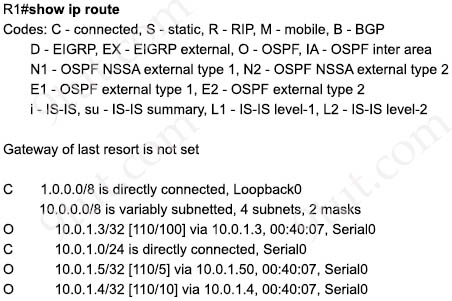OSPF Questions 2
Question 1
Question 2
Explanation
To configure OSPFv2 under interface mode we must use the command “ip ospf {process-id} area {area-id}”. For example:
R1(config-if)#ip ospf 1 area 2
Question 3
Question 4
Question 5
Explanation
After the new election, R3 and R1 have highest priority (of 2) so they will be elected DR and BDR. R3 will be elected DR because its has higher router ID (of 3.3.3.3).
Question 6
Explanation
In this question, R1 & R2 will not establish OSPF neighbor relationship because the hello & dead intervals are not the same.
If we modify the hello & dead intervals to the same values then R1 & R2 will become OSPF neighbors. But they will establish OSPF adjacency too.
Answer B is not correct as the process ID is only locally significant.
Answer C is partially correct as we need to change both “hello and dead” interval, not “hello” interval only.
Answer A is a good answer because if we change both the priorities to 0 then they cannot elect DR/BDR so the adjacency cannot be complete.
Answer D is a good answer too because if we change one of the network type to “point to point” then OSPF neighbor relationship can still come up but adjacency cannot (no routes are getting exchanged).
But two good answers are only correct after fixing the hello & dead intervals to the same value (so that OSPF neighbor relationship can come up) so answer C should be the best choice here.
Note:
Neighbors
Routers that share a common segment become neighbors on that segment. Neighbors are elected via the Hello protocol. Hello packets are sent periodically out of each interface using IP multicast (Appendix B). Routers become neighbors as soon as they see themselves listed in the neighbor’s Hello packet.
Two routers will become neighbors if they agree on the following: Same Area ID, same authentication (if used), same hello & dead intervals, same subnet mask and same stub area flag.
Adjacencies
Adjacency is the next step after the neighboring process. Adjacent routers are routers that go beyond the simple Hello exchange and proceed into the database exchange process.
The adjacency building process takes effect after multiple stages have been fulfilled. Routers that become adjacent will have the exact link-state database. The states an interface passes through before becoming adjacent to another router are: Down -> Attempt (optional) -> Init -> 2-Way -> Exstart -> Exchange -> Loading -> Full.
At Full state the adjacency is complete.
Reference: https://www.cisco.com/c/en/us/support/docs/ip/open-shortest-path-first-ospf/7039-1.html#t22
-> Two OSPF neighbors do not exchange any routing information – the only packets they exchange is Hello packets.
Adjacencies on Point-to-Point Interfaces
OSPF will always form an adjacency with the neighbor on the other side of a point-to-point interface such as point-to-point serial lines. There is no concept of DR or BDR. The state of the serial interfaces is point to point.
Question 7
Refer to the exhibit. What is the next hop address for traffic that is destined to host 10.0.1.5?

A. Loopback 0
B. 10.0.1.4
C. 10.0.1.50
D. 10.0.1.3
Answer: C
Explanation
Traffic destined to host 10.0.1.5 will match the entry “O 10.0.1.5/32 …” so the next-hop address will be 10.0.1.50.
Question 8
Explanation
We don’t need to configure hello and dead timers for OSPF neighbor as OSPF can auto negotiate the network type (with the same hello and dead timers on both sides). We just have to make sure both interfaces are running OSPF and they are in the same area ID.



Nice, Here I would like to accept that actual questions help me to pass the exam because it is real questions. I recommend readers to get actual questions with your other preparation material. Dumpsresources one of them.
What do you mean by actual questions please @ Kiki?
Q1 Can anyone confirm this?
MTU 1600 will work (with errors however), but Passive-interface won`t let neighbor relationship.
https://www.cisco.com/c/en/us/td/docs/ios-xml/ios/iproute_pi/configuration/xe-3s/iri-xe-3s-book/iri-default-passive-interface.html
“In OSPF, hello packets are not sent on an interface that is specified as passive. Hence, the device is not able to discover any neighbors”
Greg,
passive interface was configured as default, yes, but then was deny on the interface
where is the exam questions and quiz you removed it
@9tut
For Q.6
Although it is a bad question, I think the answer should be D. There are two requirements that if they are not configured correctly will result in having OSPF neighbors but not adjacency. And those two are MTU settings and OSPF network types.
So, I assume the question asks “R1 & R2 are not neighbor as configured but what changes to these configurations will result in establishing neighbor but bot adjacency”.
And the hello/dead timer is just misleading.
Apostas esportivas, apostas eSports – Ganhe até X2000 jogos de aviador por dinheiro
Apostas esportivas
An engineer must configure an OSPF neighbor relationship between router R1 and R3. The authentication configuration has been configured and the connecting interfaces are in the same 192.168.1.0/30 subnet. What are the next two steps to complete the configuration? (Choose two)
A. configure the hello and dead timers to match on both sides
B. configure the same process ID for the router OSPF process
C. configure the same router ID on both routing processes
D. configure the interfaces as OSPF active on both sides
E. configure both interfaces with the same area ID
If you configure the same process ID you are activating OSPF. (?) Wy B and E are wrong?
What do you mean by “best choice?”
C. modify hello interval
This is completely ridiculous. There is NO correct answer here. You’ve successfully crafted a question and answer set that serves no purpose but to frustrate paying members and put you on the defensive.
Please remove the practice questions like this that serve no purpose other than to create confusion before an exam.
I cant see questions
@erik you can’t see questions because you are not paying premium members….
After you pay you will have full acccess to all the practice.